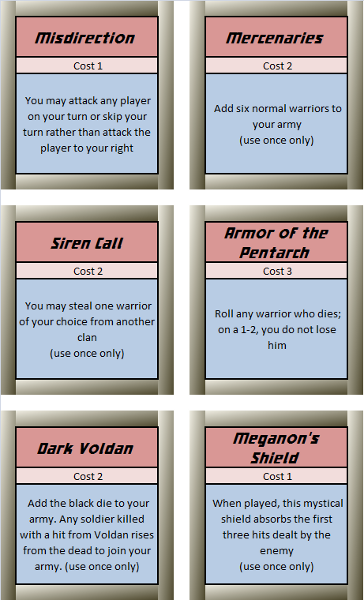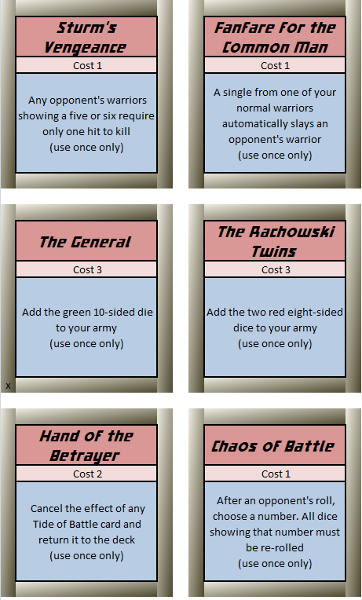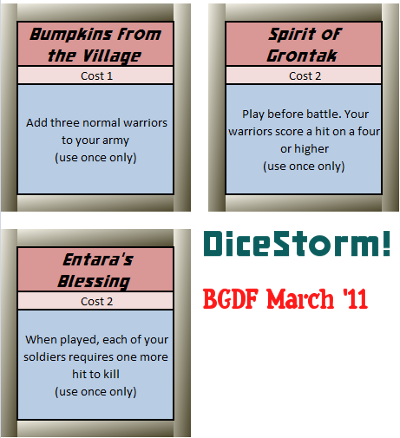I had a neat idea for a simple computer puzzle game in the middle of last week. Given that it's nearing the end of my semester, I won't have time to implement it for a month or so, but it's great to have that to look forward to. I'm going to base it on Cairo tessellation, which is a cool pentagon-based geometric pattern rumored to be common in Egyptian streets.
I always struggle to keep the spark of excitement and enthusiasm that comes with a design alive until I can actually do the work. Sometimes the spark fades away; other times, I come up with a new idea and lose interest in the old one. The result is a train of half-baked game ideas stretching back into my childhood, and only a few realized projects. Hopefully I can keep the fires going for this one.
But now I have to grade stuff.
Tuesday, March 29, 2011
Saturday, March 26, 2011
Writing Rules
There's an interesting discussion on what makes rules good over at BGG. Lots of good ideas and useful observations there for people writing rules for their own games. Also some differences of opinion - a lot of people seem to like Settlers of Catan's rules, which have an alphabetical section discussing various topics in the middle after the main rules. I'm not opposed to a glossary or something like that, but the way Catan has it set up, I often find myself trying to remember what term a particular rule is listed under, which means I have to flip around through the alphabetical section to find the rule. I'd much prefer to have all the rules listed in a structured way, where they relate to the part of the game being discussed, rather than alphabetically.
Tuesday, March 22, 2011
Dicestorm
Below is my entry in the huge February BGDF Game Design Showdown contest. It nearly made the cut for the finals, but not quite. I think it would be pretty fun; over the summer, I think I'll try to put a set together (wouldn't be too hard - just need lots of six-sided dice) and see how it plays.



Dicestorm
(c) 2011 by Dave Dobson / Plankton Games
2-4 players
2-4 players
Introduction
In the olden days, the Ur-gan clans of the Stonetop Mountains vied with each other under a strict code of mortal combat. To the losers, a decade of defeat, shame, and self-pity. To the winners, ten years of dominion over all the other clans.
You lead one of these clans in a battle to the death! Your warriors are represented by dice - each die is a warrior. When you are out of dice, your clan has lost, and you are out of the game. Will you fail, and lie unsung in a coward's grave, or will you roll to victory? (Get it? Roll? Get it?)
Components
- 30 white six-sided dice
- 1 black six-sided die
- 2 red eight-sided dice
- 1 green 10-sided die
- 4 Restoration mini-cards
- 14 Tide of Battle mini-cards
Object
Be the last player with surviving armies in the game
Setup
Each player gets a set of normal warriors (white six-sided dice). The number of starting dice depends on the number of players as follows:
- 2 players - 15 dice each
- 3 players - 10 dice each
- 4 players - 7 dice each
Each player also gets one Restoration card. Shuffle the Tide of Battle cards and place them face down nearby. Roll to see who goes first.
Game Play
Game play consists of two phases, the battle phase and the draw phase
Battle Phase
On each of your turns, you will battle with the opponent to your right. To conduct a battle, you and your opponent each roll all your warriors (your dice). Battles are resolved from the die rolls according to these rules:
- Each roll of five or higher counts as a hit
- The number showing on each die is the number of hits needed to defeat and remove that die
- The player dealing hits may decide which of the opponent's dice the hits affect
For example:
- Gollum has six dice and rolls: 6 5 4 4 2 1
- Frodo has seven dice and rolls: 6 6 5 3 2 1 1
Gollum has scored two hits, and he may either take out Frodo's two dice showing 1's or Frodo's one die showing a 2. Normally, it would be better to take out two dice rather than one, but if the die showing 2 is a special die, Gollum might want to get rid of that one. Frodo scores three hits and would probably use them to take out Gollum's two dice showing 2 and 1.
Draw Phase
After the battle is resolved, the player draws one card from the Tide of Battle deck. The player may choose to pay the cost shown on the card (the cost is paid in dice), or he may pass it to the right. The next player has the same choice - pay or pass. If the card makes it back around to the original location, the cost is reduced by one and the process repeats. Eventually the card will be bought, or the cost of the card will drop to zero, at which point it may be taken for free.
Losing
If you ever lose all of your dice, you are out of the game immediately, even if you could add more dice by playing a card.
Cards
There are two types of cards - Restoration cards and Tide of Battle cards. Restoration cards bring a player's force back up to its starting total. Tide of Battle cards can have many different effects. The following rules apply to these cards:
- Some cards have permanent effects; others can be played once only and are then discarded.
- Some cards are played at specific times in a battle or during a player's turn. Other cards can be played at any time as long as the player still has dice.
- Some cards call for additional dice to be added to a player's army. If those dice are not available when the card is played, they are not added or owed - they are lost. Partial adding is allowed (e.g. if a player is instructed to add five and three are available, he or she gets the three dice).
- If a player is ever out of warriors, he or she has lost and can play no cards, even if they would restore warriors to the player's army.
- Tide of Battle cards that are used are discarded. When all of these cards are used, shuffle the discards to restore the Tides of Battle pile.
- Restoration cards are never re-used once played.
Tide of Battle Cards
Explanations of the Tide of Battle cards are below.



Sunday, March 13, 2011
Word from Hippodice
I didn't make the finals - I don't know where I was out of the hundred or so games they took. A good experience the first time around, though. Full results are here. If (A) means Austria, it looks like 11 of the 12 mentioned on the finals page are from at least partially German-speaking countries (the other one is from the U.S.) - it hasn't been so strongly Germanic in the past, if I remember past lists.
Not that that means anything; the German gaming community is huge and diverse, with many great designers. Just an observation.
Not that that means anything; the German gaming community is huge and diverse, with many great designers. Just an observation.
Monday, March 7, 2011
Biggest Game Design Showdown ever?
This month's Game Design Showdown over at BGDF is huge - 37 entries! I think the biggest one I've ever seen is twelve or so. I've got one in, so we'll see how it looks compared to the huge field.
Why so many? Probably because there's a publisher interested (Michael Mindes of Tasty Minstrel Games), and the restrictions in the contest are actually his design specifications for a potential publication. Also, because those specifications are mostly just that you use dice with only limited other components, and nearly everybody can think of a design for a dice game.
There's no guarantee that any of the entries would be published, of course, and no guarantee that the winner of the contest would be the one that TM selects, since they'd have different ideas about marketability and design than the contest voters, but maybe that has people interested. I'm not sure the regular voting apparatus (up to six votes, no more than three per game, no voting for your own) are going to be workable here - it's usually a bit mysterious who wins, and usually few people vote. But maybe having so much interest will make for more voting and less quirkiness.
Should be interesting - I'll let you know how I do, and we can see if any of the entries sparks Michael's interest.
Why so many? Probably because there's a publisher interested (Michael Mindes of Tasty Minstrel Games), and the restrictions in the contest are actually his design specifications for a potential publication. Also, because those specifications are mostly just that you use dice with only limited other components, and nearly everybody can think of a design for a dice game.
There's no guarantee that any of the entries would be published, of course, and no guarantee that the winner of the contest would be the one that TM selects, since they'd have different ideas about marketability and design than the contest voters, but maybe that has people interested. I'm not sure the regular voting apparatus (up to six votes, no more than three per game, no voting for your own) are going to be workable here - it's usually a bit mysterious who wins, and usually few people vote. But maybe having so much interest will make for more voting and less quirkiness.
Should be interesting - I'll let you know how I do, and we can see if any of the entries sparks Michael's interest.
Subscribe to:
Posts (Atom)















